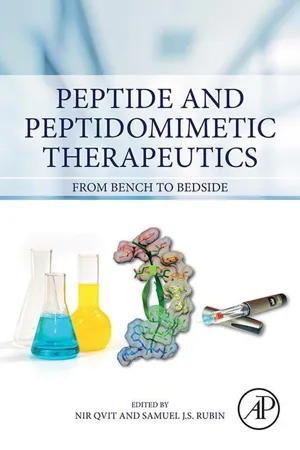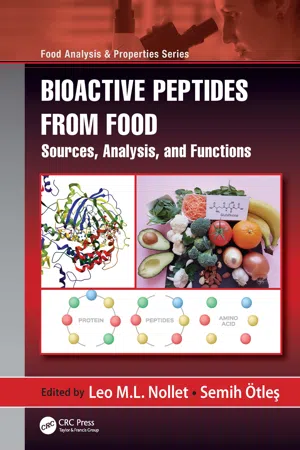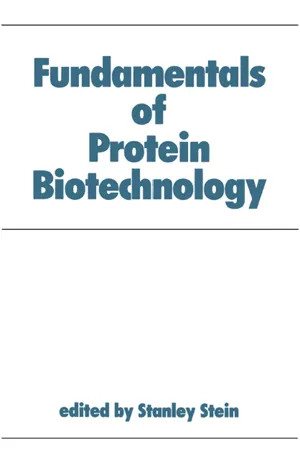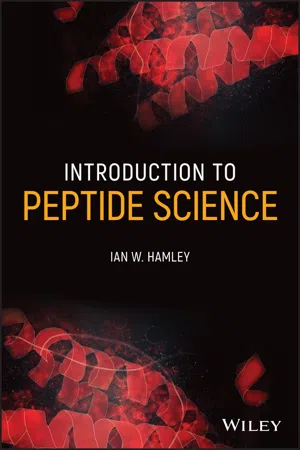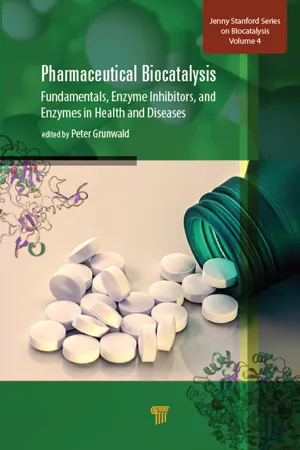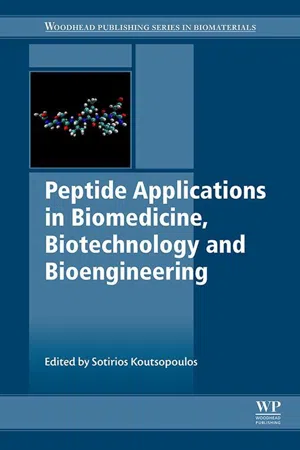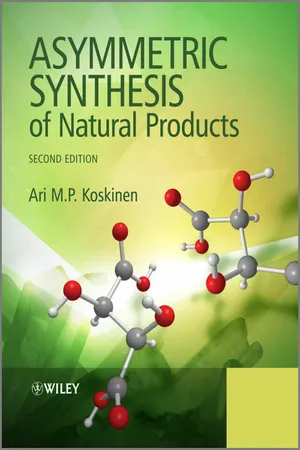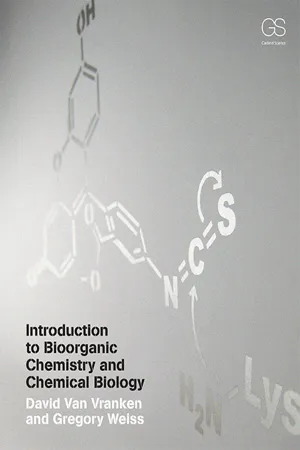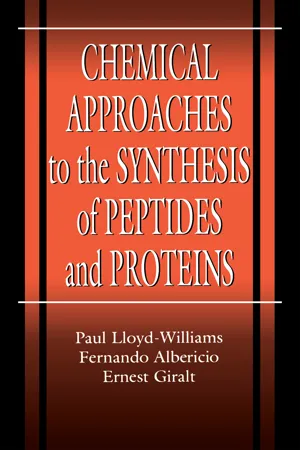Chemistry
Peptide Synthesis
Peptide synthesis is the chemical process of creating peptides, which are short chains of amino acids. This can be achieved through solid-phase synthesis or liquid-phase synthesis. In solid-phase synthesis, the peptide is built on a solid support, while in liquid-phase synthesis, the peptide is assembled in solution. Peptide synthesis is important in the production of pharmaceuticals, research, and biotechnology.
Written by Perlego with AI-assistance
Related key terms
Related key terms
1 of 4
Related key terms
1 of 3
12 Key excerpts on "Peptide Synthesis"
- eBook - ePub
Peptide and Peptidomimetic Therapeutics
From Bench to Bedside
- Nir Qvit, Samuel J.S. Rubin(Authors)
- 2022(Publication Date)
- Academic Press(Publisher)
Biological or bioactive peptides derived from animals, plants or humans (1) are isolated from natural peptide-based hormones or as subcomponents of larger proteins; (2) are produced using recombinant DNA technology; or (3) are discovered using chemical libraries. The production method used for a peptide is mostly governed by the size and the chemical structure of the peptide [7]. Various methods of Peptide Synthesis such as chemical pathway of production, recombinant DNA technology, and synthesis using transgenic animals or plants have evolved over time [8]. Chemical synthesis is the most widely used method of production, as most peptide therapeutics involve unnatural amino acids or the formation of (pseudo) peptide bonds, which can be easily produced using this pathway rather than employing recombinant DNA technology. Chemical synthesis allows the development of peptides ranging from 5 to 50 residues and produces one of the most pharmaceutically relevant molecules [7]. Peptides are mostly defined based upon their chemical method of synthesis, primarily, the solid-phase Peptide Synthesis [5, 9]. Nowadays, development of therapeutic peptides by the pharmaceutical industries has become easily accessible due to the advancements in solid-phase Peptide Synthesis [9]. Solid-phase Peptide Synthesis allows for easy production of peptides in the early stages of preclinical research and the development of pharmaceutical agents using active peptides as targeting agents, or active pharmaceutical ingredients. Solid-phase Peptide Synthesis involves three different routes of synthesis, namely, sequential, convergent, and chemical ligation synthesis. The process of sequential synthesis involves the consecutive incorporation of peptides until the desired sequence is attained - eBook - ePub
Bioactive Peptides from Food
Sources, Analysis, and Functions
- Leo M.L. Nollet, Semih Ötleş(Authors)
- 2022(Publication Date)
- CRC Press(Publisher)
This technique of Peptide Synthesis has advantages over conventional methods as it gives higher yields, high product purity, faster, etc. Peptide Synthesis is a complex technique in which desired amino acids are synthesized after multiple steps. There are various potential combinations produced in this method, from 20 common amino acids present in nature. Peptide Synthesis is fascinating and challenging because of its complexity (Merrifield, 1986). When two amino acid solutions are combined, four different dipeptides can be formed (for example, the four dipeptides for a glycine and alanine mixture will be gly-gly, gly-ala, ala-gly, ala-ala. The free amino group or N -terminus is on the left-hand amino acid in this representation of peptides and the free carboxylic acid group is on the right-hand end of the C -terminus). To ensure the synthesis of the desired dipeptide, the basic group of one amino acid and the acidic group of the other must both be made unable to react. This deactivation is known as the protection of reactive groups, and a group that is unable to react is called a protected group (Kemp and Carey, 1993). In classical Peptide Synthesis, the acids are protected, permitted to react, and then deprotected, after which one end of the dipeptide is protected and reacted with a new protected acid, and so on. In SPPS, the amino acid at one end of the peptide is bound to a water-insoluble polymer/resin and remains protected during the peptide’s creation, suggesting that less protection steps are needed and that the reagents can be rinsed away without losing any of the peptide (Merrifield, 1996). The steps involved in the chemical synthesis of bioactive peptides in SPPS are discussed below and presented in Figure 17.2 : FIGURE 17.2 Schematic representation of solid-phase Peptide Synthesis (SPPS). Linking of Amino Acids with Resins The SPPS process involves binding the first amino acid to a resin, then elongating the peptide chain to generate the desired peptide - eBook - ePub
- Stein(Author)
- 2017(Publication Date)
- CRC Press(Publisher)
An understanding of the relationship of a peptide or protein structure to its function is essential for the rational design of molecules with predicted properties that can be exploited for research and in the clinic. The chemical synthesis of peptides has a fundamental role in this area of modern biological research. Systematic variations in structure can be correlated with the properties of the resultant molecules; a direct approach to the identification of functional domains or of specific amino acids having specialized roles in the molecule of interest. These efforts are critically important since there is not yet a full appreciation of how the amino acid sequence of a peptide or protein directs its proper folding into a preferred bioactive conformation or a precise three-dimensional structure, giving rise to its unique properties. Macromolecular interactions, and the mechanisms governing biorecognition, particularly ligand/receptor interactions, must also be understood in order to design structures with predicted properties, and chemically synthesized peptides contribute to this goal as well. These and other applications of peptides have depended in large measure upon the accessibility of purified synthetic peptides ever since the first synthesis, in 1953, of a biologically active peptide hormone by du Vigneaud and his co-workers. The hormone was the cyclic octapeptide, oxytocin. Recent advances in the technology of chemical Peptide Synthesis, purification, and structural analysis have made such molecules more generally available, and the use of peptides in biomedical research and pharmaceutical development is expanding rapidly.BACKGROUNDThe term polypeptide was proposed in 1906 by Emil Fischer to describe structures consisting of variable numbers of amino acids linked together by amide bonds. The basic structural features of a linear peptide are illustrated in Figure 1 . A peptide bond is formed by a condensation reaction between two amino acids; the carboxyl group of one amino acid forms an amide bond with the amino group of a second amino acid, and a molecule of water is eliminated. The amino acids, which are called residues when they occur in peptide linkage, are conventionally numbered consecutively starting at the amino (N) terminus. The repetitive peptide backbone, which is all of the molecule except for the side-chain (R) groups, is defined by its length and by its direction. Each amino acid residue is distinguished by its side-chain moiety, which is attached to the alpha carbon atom (Fig. 1 - eBook - ePub
- Ian W. Hamley(Author)
- 2020(Publication Date)
- Wiley(Publisher)
2 Synthesis2.1 INTRODUCTION
The main route to synthesize peptides in the laboratory is solid‐phase Peptide Synthesis (SPPS ). This was among the first chemistries to be developed for automated synthesis, building on Bruce Merrifield's Nobel Prize winning research in the 1960s. It has been possible to perform these reactions to synthesize shorter peptides using commercially available peptide synthesizers for some time now. This is the subject of Section 2.2 in this chapter, which covers the key reactions, choice of solid‐phase resins, protecting‐group strategies, and common side reactions. Solution‐phase synthesis is briefly mentioned in Section 2.3 .Many strategies are available to prepare longer peptides via convergent synthesis methods or via recombinant expression techniques and these are discussed in Section 2.4 .When screening peptides for different types of activities, it is common to prepare large libraries of peptides and methods to produce peptide libraries are outlined in Section 2.5 .Cyclic peptides have evolved naturally, for example several types of antimicrobial peptides are cyclic (Chapter 4 ). Inspired by this, synthetic cyclic peptides are of great interest since they can exhibit enhanced stability against degradation in vivo, and the steric constraints imposed can be used to enhance the selectivity or specificity of interaction of the peptide with cell receptors. Section 2.6 of this chapter discusses methods to prepare cyclic peptides. Molecules that resemble peptides, termed peptidomimetics, are considered in Section 2.7 .This chapter also covers more recent advances in the synthesis of hybrid peptide biomaterials such as polymer–peptide conjugates. Such methods underpin developments in chemical biology related to peptides and proteins. Section 2.8 introduces post‐translational modifications, which include proteolytic processing, modifications of the termini, lipidation, and glycosylation. Conjugation of lipids, glycopolymers (poly‐ or oligo‐saccharides), or polymers can improve the stability and activity of peptides and synthetic methods to attach these moieties are discussed in turn in Sections 2.9 –2.11 - eBook - ePub
Pharmaceutical Biocatalysis
Fundamentals, Enzyme Inhibitors, and Enzymes in Health and Diseases
- Peter Grunwald(Author)
- 2019(Publication Date)
- Jenny Stanford Publishing(Publisher)
Recently, bioactive peptides of animals, plants, and microorganism origins are significantly utilized in the treatment and prevention of cardiovascular diseases, cancer and infections (Cicero et al., 2017). Likewise, antimicrobial peptides with enhanced bioactivity are used to inhibit the growth of harmful microbes and prevent the widespread of their associated diseases (Haney et al., 2017). Hence, researchers are utilizing bioactive peptides as an alternate to conventional pharmaceutical entities to develop peptide-based treatment approaches. Thus, the current chapter is an overview of current synthesis methods that are used to synthesize bioactive peptides as they are the determining factor that elevates their bioactivity. Further, the procedures employed for the refinement, characterization and formulation of bioactive peptides in recent times and their pharmaceutical applications are also presented. Additionally, the existing challenges and the bioactive peptides in the future of pharmaceutical industry are also discussed.6.2 Synthesis of Bioactive Peptides
The synthesis of bioactive peptides is highly significant in determining the biological properties of these peptides. The synthesis procedures that are conventionally and recently available for peptide production are shown in Fig. 6.1 .The chemical-based fabrication approach is the conventional approach to produce synthetic peptides that have been developed over years with the help of efficient coupling reagents.6.2.1 Chemical Synthesis
Basic principle: Chemical synthesis of peptides involves the mechanism of protection and activation. The activation of the carboxylic acid (RCOOH) by chemical reagents in the amino acid generates active acyl group (R-CO-) that forms strong peptide bonds, followed by nucleophilic α-amino group attack (H2 N-R). The protection of the sensitive functional clusters that are not included in the formation of peptide bond (Machado et al., 2004) are envisioned to enhance chemical selectivity that are essential for the precise sequence of Peptide Synthesis (David and Luis, 2001). There are three methods of chemical-based Peptide Synthesis and they are solution, solid phase, and sequential fragment condensation.6.2.1.1 Synthesis in solution
This is the classical convergent fragment condensation technique used to produce small peptides in solution. In convergent synthesis, peptides are sequentially synthesized individually and then linked in solution. The main advantage of this technique is the specific discrimination between the reactants and the product. Therefore, the intermediate short peptides formed in solution can be easily purified after every synthesis step and can be recombined to generate large peptides after de-protection. Other advantages of this method are that it takes less time and is relatively less expensive. However, this method has certain disadvantages such as poor solubility, lack of advanced methods to purify protected peptides and racemization of activated amino acids in peptides preferably at the c-terminal of histidine and cysteine amino acids (Kent, 1988; Perez Espitia et al., 2012). - Sotirios Koutsopoulos(Author)
- 2017(Publication Date)
- Woodhead Publishing(Publisher)
Peptides are ubiquitous in biomedicine, drug discovery, drug delivery, cosmetics, food industry, and several other fields. They are distinguished from proteins based on their smaller size (<40 amino acids) participating in most physiological processes including signal transduction, heart rate regulation, food intake, and growth. Although more than 7000 naturally occurring peptides have been discovered, inefficient and expensive manufacturing processes have hampered the development of peptide-based therapeutics. During the last two decades peptide research has seen significant growth due to several technological improvements. Despite their limitations, i.e., proteolytic instability and poor oral bioavailability, recent advances in peptide design and synthesis (including the incorporation of nonproteinogenic modifications) have revived the field of peptide therapeutics.With more than 60 peptide drugs already in the market, approved by the Food and Drug Administration (FDA), about 140 peptide drugs currently in clinical trials, and 500–600 in preclinical development peptide-based pharmaceuticals are becoming a growing class of therapeutic agents with high economic potential for the pharmaceutical industry [1] .This introductory part would be incomplete without citing some key events in the history of Peptide Synthesis. Everything began in 1901 when Emil Fischer (Nobel Prize in Chemistry 1902) and his colleagues synthesized the first dipeptide, glycylglycine, whereas in 1881 Theodor Curtius had already synthesized the first N -protected dipeptide, benzoylglycylglycine. Emil Fischer introduced the term “peptide bond” and “peptide” so that he is considered the father of peptide chemistry. Thirty years later, in 1932, Leonidas Zervas developed the carbobenzoxy protecting group (Cbz or Z, in honor of its inventor) and in 1953 Vincent du Vigneaud reported the synthesis in solution of the endogenous cyclic nonapeptide hormone, oxytocin. For this landmark achievement he was awarded the Nobel Prize in 1955. Ten years later, in 1963, Bruce Merrifield introduced solid-phase Peptide Synthesis (SPPS), and for “his development of methodology for chemical synthesis on a solid matrix” he was awarded with the Nobel Prize in Chemistry in 1984. SPPS methodology was a real revolution opening new horizons in the field of peptide and protein chemistry [2] . This simple method, which is based on the coupling of protected amino acids onto an insoluble solid support, simplifies the procedure, making the Peptide Synthesis compatible with automatic processes enabling large-scale production. Until the early 2000s, the prices of the raw material and yields of Fmoc-based SPPS were not sufficient to support large-scale production. The main disadvantage of SPPS on an industrial scale was the requirement for expensive resins or large amounts of amino acid derivatives and coupling reagents, making the synthesis of the peptides profitless due to the high overall cost of manufacturing [3] . Nevertheless, Trimeris and Roche developed a hybrid approach (SPS and SPPS) which allowed for the production the peptide drug enfuvirtide (Fuzeon, Roche), a 36-amino-acid peptide, on a metric ton-scale in a cost-efficient way. Three small protected fragments were constructed via solid-phase Peptide Synthesis and then after cleavage from the solid support, purification and characterization, the three fragments were condensed in solution [4]- eBook - ePub
Advanced Chemical Biology
Chemical Dissection and Reprogramming of Biological Systems
- Howard C. Hang, Matthew R. Pratt, Jennifer A. Prescher(Authors)
- 2023(Publication Date)
- Wiley-VCH(Publisher)
in situ activation of the incoming amino‐acyl carboxylate, (ii) produces only water as a by‐product, (iii) occurs in aqueous solution, and (iv) does not require the use of protecting groups.Chemical Peptide Synthesis is a highly optimized branch of synthetic organic chemistry. Addition and removal of appropriate protecting groups for both side‐chain and backbone functionalities as well as efficient methods for activating the carboxylic acid of the incoming amino acid have provided fertile ground for synthetic developments. In solid‐phase Peptide Synthesis (SPPS ) [4] , an Nα ‐protected amino acid is coupled to a resin‐bound amine in aprotic, polar organic solvents. Reactive amino acid side chains (Table 7.1 ) are orthogonally protected to minimize undesired reactions involving the incoming activated amino acids and the growing peptide chain.7.2.1 SPPS Is Optimized for Stepwise Efficiency
Solid‐phase methodology is often employed for Peptide Synthesis. SPPS is a sequential process, wherein a nascent peptide chain is constructed on a solid support (Figure 7.2 ). Iterations of Nα ‐amino deprotection and addition of an activated carboxylic acid continue until the desired sequence is attained. The solid‐phase methodology offers two key advantages over solution phase synthesis: (i) the purification of intermediate peptides after each coupling cycle has been significantly simplified through the tethering of the growing peptide to a solid support, allowing unreacted reagents to be washed away and (ii) each reaction can be driven to completion with excess reagents and activated amino acids. Efficiency of both the coupling and deprotection steps is critical to the success of Peptide Synthesis, i.e. synthesis of a 100‐residue peptide with 99% efficiency at each step provides 90% of the desired peptide, while 95% efficiency would lead to a 5% overall yield [5] . In comparison, a 95% stepwise yield for a 10‐residue peptide gives an overall yield of 60%, whereas a stepwise yield of 75% yields just 5% of the desired 10‐mer. The use of additives, solvent mixtures, and pseudoproline or depsipeptide methodologies is often beneficial to minimize side reactions, racemization, or chain aggregation, which can produce impurities with similar chemical properties that are costly to purify from the desired product [6 , 7 - eBook - ePub
Synthetic Peptide Vaccine Models
Design, Synthesis, Purification and Characterization
- Mesut Karahan(Author)
- 2021(Publication Date)
- CRC Press(Publisher)
The protection of side chain functional groups is necessary to prevent undesirable reactions and to form univocally the goal peptide bond. The peptide bonds are also called eupeptide bonds to distinguish them from isopeptide bonds formed by participating side chain functional groups as is the case of glutathione for example. Peptide Synthesis is a multistage process comprising a number of chemical processes. To provide an overall high yield of the goal peptide it is drastically important to have yields close to quantitative at all stages of this complex process. It is also extremely important to avoid even a low racemization at all stages otherwise the obtained peptide will lack the desirable physiological activity (Isidro-Llobet, Álvarez, and Albericio 2009). Today peptides are being synthesized using automated solid-phase Peptide Synthesis (see Chapter 4). The process is substantially promoted by microwave assistance (Figure 3.4). FIGURE 3.4 Example of amino acids structures. Side chain groups and alpha carbon groups (Yarus 2017). 3.7 Protecting Groups of Na-Amino and C-Terminal Carboxyl Functions in Solid-Phase Peptide Synthesis N-protecting : There are several groups to protect the N-terminus of amino acids. They are called temporary protecting groups since in case of need they can easily be removed. The most popular and commonly used N-protecting groups are tert-butoxycarbonyl (Boc) and benzoyloxycarbonyl (Cbz or also labeled Z) (Lin et al. 2000; De Marco et al. 2013; Isidro-Llobet, Álvarez, and Albericio 2009). C-protecting : These groups are responsible for protecting the C-terminus of amino acids. The classical solution method is preferred in Peptide Synthesis. The stability ratio in the solid phase Peptide Synthesis is low. The most commonly used carboxyl-protecting groups are methylethyl and benzylesters (De Marco et al - eBook - ePub
- Ari M. P. Koskinen(Author)
- 2012(Publication Date)
- Wiley(Publisher)
Chapter 5 Amino Acids, Peptides, and ProteinsPeptides and proteins play a central role in the function of cells and organs. Large proteins can support the structure of the cell. Proteins catalyzing chemical transformations are called enzymes. Some proteins participate in the transfer of information and signals between cells, where they are called receptors. Enzymes and receptors are often extremely sensitive in recognizing specific molecules, and by way of their intrinsic asymmetric structure, they exhibit high discrimination toward optical antipodes. This phenomenon is known as substrate selectivity. Smaller peptides can function as chemical messenger molecules in vital signal transduction processes, for example, in the central nervous system (neurotransmitters) and hormonal activity (peptide hormones).Whether one considers a large enzyme complex composed of several peptide chains, which catalyzes chemical reactions, or a small neurotransmitter peptide, they share the common feature of being constructed of amino acids.In this chapter, we will take a look at the amino acids and polypeptides, especially in terms of structure and synthesis. We shall finally briefly review enzymes, their properties and function, and the factors controlling them.5.1 Amino Acids
Natural peptides and proteins are built from 21 so-called natural or more appropriately DNA-encoded or proteinogenic amino acids (Figure 5.1 ). Twenty of them occur universally in living species, and are coded for by three-codon sequences in DNA (Figure 5.2 ). Selenocysteine and pyrrolysine (see Scheme 5.11 ) are coded for in certain species at the mRNA level indirectly by overriding the natural stop codons (TGA for selenocysteine and TAG for pyrrolysine). The amino acids are, with the exception of glycine, optically active, in other words their α-carbon is asymmetrically substituted. With the exception of certain microbial products, all natural amino acids belong to the same stereochemical series (l), where the absolute stereochemistry of the chiral carbon is S. Cysteine makes an exception, where the stereochemical designation is R - David Van Vranken, Gregory A. Weiss(Authors)
- 2018(Publication Date)
- Garland Science(Publisher)
Protection of the N and C termini prevents polymerization, whereas protection of the side chains prevents branching and other undesired reactions (Figure 5.11). Successful Peptide Synthesis requires a deep understanding of structure, reactivity, and mechanism so as to anticipate problems and design conditions accordingly. Protecting groups for the N or C termini must be labile enough to remove without affecting the side-chain protecting groups. The side-chain protecting groups must be robust enough to withstand round after round of acidic or basic reactions. Figure 5.11 Selective protection in Peptide Synthesis. Protecting the indicated functional groups is required to avoid side reactions during amide bond formation. Chemical Peptide Synthesis involves repeated additions of activated carboxylates to the N terminus In theory, it should be possible to couple each amino acid at the N or C terminus of a suitably protected peptide (Figure 5.12). Unfortunately, however, the condensation of amines with the C terminus of a peptide is accompanied by a competing cyclization that ultimately ruins the growing peptide because of epimerization. When synthesizing a peptide in the N-to-C direction, the entire peptide is ruined. In contrast, when synthesizing the peptide in the C-to-N direction, only the amino acid reagent is ruined. During each round of coupling, it is better to lose 5% of the plentiful amino acid reagent than to ruin 5% of the peptide chains. Figure 5.12 Peptides can be elongated by adding a protected amino acid to either the N terminus or the C terminus. Once a carboxylic acid is activated, nearby carbonyl groups can participate in an unwanted cyclization (indicated with a dashed arrow). Depending on the strategy, the cyclization either ruins the amino acid reagent or ruins the growing peptide chain- Paul Lloyd-Williams, Fernando Albericio, Ernest Giralt(Authors)
- 2020(Publication Date)
- CRC Press(Publisher)
271 Among its advantages over conventional segment-coupling methods are that, first, the solubility of the intermediates in aqueous solvent systems is improved owing to the lack of side chain protection. Second, the intramolecular acyl transfer reaction is fast, usually being complete within a few hours at most and sometimes within minutes. Third, the use of excesses of one of the segments is avoided. However, it does not constitute a general approach to Peptide Synthesis since it is only applicable in cases where there is a convenient distribution of Cys residues. Also, the chemistry involved is rather intricate and careful selection of protecting groups is required. As it has been relatively little tried, it remains to be seen whether or not such template-assisted synthesis establishes itself as a general method for coupling peptide segments.SCHEME 4.34 Chemical ligation of partially protected peptide 4-mercapto-6-(peptidyloxy)dibenzo-furan ester 140 and N-terminal cysteine-containing peptide 142 by disulfide formation.SCHEME 4.35 Template-assisted intramolecular acyl transfer to give an amide bond between the two peptide segments.SCHEME 4.36 Native chemical ligation.4.4.2.2 Native Chemical Ligation
Kemp’s thiol capture ligation demonstrates that amide bond formation, even between large peptide segments with only moderate activation, can be rapid when the reacting amino and carboxyl termini are held in close proximity. An alternative approach, which does not rely upon the use of a template, has been devised by Kent.272 It involves the chemical ligation of two unprotected segments by thioester formation, prior to the creation of an amide bond between them. For this to be possible, one of the peptides must have cysteine as its N-terminus and the other a thioester C-terminus. In model experiments, using H-Cys-OH and a pentapeptide thiobenzyl ester 146 (R = Bzl), initial chemical ligation gives cysteine thioester 147. Amide bond formation to give hexapeptide 148 then takes place. The mechanism of such coupling is thought to be that shown in Scheme 4.36- eBook - ePub
Peptides
Synthesis, Structures, and Applications
- Bernd Gutte(Author)
- 1995(Publication Date)
- Academic Press(Publisher)
2 , in very high yield. This method is somewhat more general than the thiol capture method, requires fewer steps, is applicable to completely unprotected peptides, operates in aqueous solution, is racemization free, and proceeds in good yield. It has been evaluated by the synthesis of a 50-residue analog of transforming growth factor containing one disulfide bond.It is reasonable to expect that these new ligation methods will lead to efficient syntheses of considerably longer proteins than have been possible in the past.Figure 16 Segment synthesis by aldehyde capture.C. Multiple Simultaneous Peptide Synthesis and Construction of Peptide Libraries by Combinatorial Methods
These techniques have simplified our ability to synthesize peptides by orders of magnitude, and they represent major advances in the application of Peptide Synthesis to other fields of research. These important and exciting developments must be left for other chapters of this volume.D. Design and Synthesis of Protein–Nucleic Acid Hybrids
Protein–nucleic acid hybrids (PNAs) are a new class of compounds in which individual nucleobases are linked to an achiral peptide backbone. They were designed to compete specifically for binding to one strand of a DNA duplex (Nielsen et al. , 1991;Egholm et al. , 1993). It was estimated, using computer graphics, that the optimal number of bonds between the bases of a DNA duplex is six and the number of bonds between the backbone and the base is two to three. To simulate such a structure, N 1 -carboxymethylthymine was coupled to N3 of Boc-aminoethylglycine to give a thymine-containing amino acid derivative that could then be extended by solid-phase synthesis to an oligomer in which the sugar phosphates of a polynucleotide were replaced by branched-chain amino acids (Fig. 17 ) (Berg et al. , 1993). Binding to double-stranded A and T DNA chains was shown to take place by strand displacement, in which the PNA is bound to the Watson–Crick complementary adenine-containing strand. Hoogsteen base pairing probably can also take place. In this example the thymine-containing strand of the duplex was excluded in a single-strand conformation. The binding was 2:1 PNA-DNA and was much strong than DNA–DNA binding, probably by the elimination of repulsive phosphate anions. The change in melting temperature (ΔT
Index pages curate the most relevant extracts from our library of academic textbooks. They’ve been created using an in-house natural language model (NLM), each adding context and meaning to key research topics.
Explore more topic indexes
Explore more topic indexes
1 of 6
Explore more topic indexes
1 of 4
